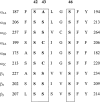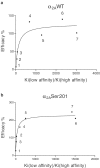Molecular mechanisms of ligand-receptor interactions in transmembrane domain V of the alpha2A-adrenoceptor
- PMID: 12970108
- PMCID: PMC1574035
- DOI: 10.1038/sj.bjp.0705439
Molecular mechanisms of ligand-receptor interactions in transmembrane domain V of the alpha2A-adrenoceptor
Abstract
1. The structural determinants of catechol hydroxyl interactions with adrenergic receptors were examined using 12 alpha2-adrenergic agonists and a panel of mutated human alpha2A-adrenoceptors. The alpha2ASer201 mutant had a Cys --> Ser201 (position 5.43) amino-acid substitution, and alpha2ASer201Cys200 and alpha2ASer201Cys204 had Ser --> Cys200 (5.42) and Ser --> Cys204 (5.46) substitutions, respectively, in addition to the Cys --> Ser201 substitution. 2. Automated docking methods were used to predict the receptor interactions of the ligands. Radioligand-binding assays and functional [35S]GTPgammaS-binding assays were performed using transfected Chinese hamster ovary cells to experimentally corroborate the predicted binding modes. 3. The hydroxyl groups of phenethylamines were found to have different effects on ligand affinity towards the activated and resting forms of the wild-type alpha2A-adrenoceptor. Substitution of Ser200 or Ser204 with cysteine caused a deterioration in the capability of catecholamines to activate the alpha2A-adrenoceptor. The findings indicate that (i) Cys201 plays a significant role in the binding of catecholamine ligands and UK14,304 (for the latter, by a hydrophobic interaction), but Cys201 is not essential for receptor activation; (ii) Ser200 interacts with the meta-hydroxyl group of phenethylamine ligands, affecting both catecholamine binding and receptor activation; while (iii) substituting Ser204 with a cysteine interferes both with the binding of catecholamine ligands and with receptor activation, due to an interaction between Ser204 and the para-hydroxyl group of the catecholic ring.
Figures





Similar articles
-
The effect of site-directed mutagenesis of two transmembrane serine residues on agonist-specific coupling of a cloned human alpha2A-adrenoceptor to adenylyl cyclase.Br J Pharmacol. 1999 Jun;127(4):877-86. doi: 10.1038/sj.bjp.0702614. Br J Pharmacol. 1999. PMID: 10433494 Free PMC article.
-
Ligand recognition of serine-cysteine amino acid exchanges in transmembrane domain 5 of alpha2-adrenergic receptors by UK 14,304.J Neurochem. 2000 Apr;74(4):1705-10. doi: 10.1046/j.1471-4159.2000.0741705.x. J Neurochem. 2000. PMID: 10737629
-
Molecular mechanism for agonist-promoted alpha(2A)-adrenoceptor activation by norepinephrine and epinephrine.Mol Pharmacol. 2001 May;59(5):1343-54. doi: 10.1124/mol.59.5.1343. Mol Pharmacol. 2001. PMID: 11306720
-
Molecular basis for the stereoselective interactions of catecholamines with alpha-adrenoceptors.Proc West Pharmacol Soc. 1998;41:225-8. Proc West Pharmacol Soc. 1998. PMID: 9836297 Review.
-
Ligands of Adrenergic Receptors: A Structural Point of View.Biomolecules. 2021 Jun 24;11(7):936. doi: 10.3390/biom11070936. Biomolecules. 2021. PMID: 34202543 Free PMC article. Review.
Cited by
-
Structural Insight into the Mechanism of 4-Aminoquinolines Selectivity for the alpha2A-Adrenoceptor.Drug Des Devel Ther. 2020 Jul 3;14:2585-2594. doi: 10.2147/DDDT.S214157. eCollection 2020. Drug Des Devel Ther. 2020. PMID: 32694911 Free PMC article.
-
Transmembrane segment five serines of the D4 dopamine receptor uniquely influence the interactions of dopamine, norepinephrine, and Ro10-4548.J Pharmacol Exp Ther. 2010 Jun;333(3):682-95. doi: 10.1124/jpet.109.164962. Epub 2010 Mar 9. J Pharmacol Exp Ther. 2010. PMID: 20215412 Free PMC article.
-
Involvement of the first transmembrane segment of human α(2) -adrenoceptors in the subtype-selective binding of chlorpromazine, spiperone and spiroxatrine.Br J Pharmacol. 2011 Nov;164(5):1558-72. doi: 10.1111/j.1476-5381.2011.01520.x. Br J Pharmacol. 2011. PMID: 21649638 Free PMC article.
-
Functional rescue of beta-adrenoceptor dimerization and trafficking by pharmacological chaperones.Traffic. 2009 Aug;10(8):1019-33. doi: 10.1111/j.1600-0854.2009.00932.x. Epub 2009 Jun 9. Traffic. 2009. PMID: 19515093 Free PMC article.
-
The second extracellular loop of alpha2A-adrenoceptors contributes to the binding of yohimbine analogues.Br J Pharmacol. 2007 Aug;151(8):1293-304. doi: 10.1038/sj.bjp.0707330. Epub 2007 Jun 11. Br J Pharmacol. 2007. PMID: 17558432 Free PMC article.
References
-
- AMBROSIO C., MOLINARI P., COTECCHIA S., COSTA T. Catechol-binding serines of β2-adrenergic receptors control the equilibrium between active and inactive receptor states. Mol. Pharmacol. 2000;57:198–210. - PubMed
-
- BALDWIN J.M., SCHERTLER G.F., UNGER V.M. An α-carbon template for the transmembrane helices in the rhodopsin family of G-protein-coupled receptors. J. Mol. Biol. 1997;272:144–164. - PubMed
-
- BALLESTEROS J.A., WEINSTEIN H.Integrated methods for the construction of three-dimensional models and computational probing of structure-function relations in G protein-coupled receptors Receptor Molecular Biology 1995San Diego: Academic Press, Inc; 366–427.ed. Sealfon, S.C. pp
-
- BERGMAN D.L., LAAKSONEN L., LAAKSONEN A. Visualizations of solvation structures in liquid mixtures. J. Mol. Graph. Model. 1997;15:301–303. - PubMed
Publication types
MeSH terms
Substances
LinkOut - more resources
Full Text Sources

